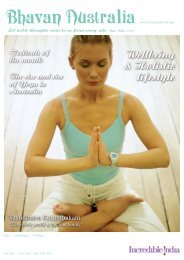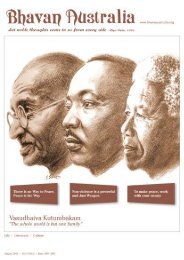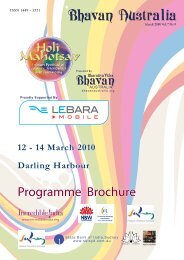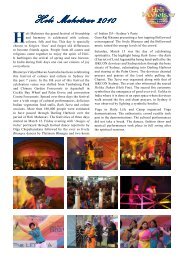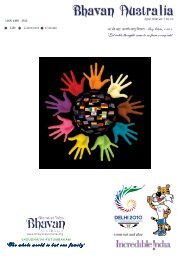The whole world is but one family - Bharatiya Vidya Bhavan Australia
The whole world is but one family - Bharatiya Vidya Bhavan Australia
The whole world is but one family - Bharatiya Vidya Bhavan Australia
Create successful ePaper yourself
Turn your PDF publications into a flip-book with our unique Google optimized e-Paper software.
mothers. Women’s rights organ<strong>is</strong>ations which are<br />
doing support work for women in d<strong>is</strong>tress have<br />
started giving due importance to counseling for<br />
peace building.<br />
<strong>The</strong> quest for peace <strong>is</strong> an eternal pursuit for human<br />
fulfilment. Peace or absence of antagon<strong>is</strong>tic,<br />
violent, or destabil<strong>is</strong>ing conflict <strong>is</strong> essential for<br />
ex<strong>is</strong>tence to become life, for survival to become<br />
human.<br />
Women as Survivors of Violence & Conflict<br />
Eyes raining, without mere control,<br />
Scruples hurt, thus dew drops roll.<br />
Lightened, piercing, still with grief,<br />
Forever, staring in d<strong>is</strong>belief.<br />
Hearts melting, defences down,<br />
Afflicted feelings, all around.<br />
Timeless moments, of unending sorrow,<br />
Darkened scars, that n<strong>one</strong> can borrow.<br />
Deep in hurdles, full with d<strong>is</strong>tress,<br />
Pleasures replaced, by pure sadness.<br />
Love’s dem<strong>is</strong>e, of responsive pain,<br />
A day’s repose, then it starts again.<br />
“<strong>The</strong>re may be an apparent<br />
stability and absence<br />
of conflict in situations<br />
of successful intense<br />
repression—beating, abuses,<br />
psychological torture...”<br />
Th<strong>is</strong> poem by a survivor of violence and conflict,<br />
Ms. Lara Jesani portrays the pain and agony<br />
that every woman faces with domestic violence,<br />
communal/caste/ethnic violence and violence as<br />
a result of war. Mohalla Committee Movement<br />
(MCM) in Mumbai was formed with a firm<br />
understanding that the quest for peace <strong>is</strong> an eternal<br />
pursuit for human fulfilment. MCMs were formed to<br />
counter communal frenzy during Bombay riots in<br />
1992-93. In the words of its founder-member Julio<br />
Franc<strong>is</strong> Ribeiro, “After the riots in Mumbai in 1992,<br />
a long term, interventionary and developmental<br />
solution was deemed necessary. <strong>The</strong> creation<br />
of Mohalla Committees was <strong>one</strong> of the solutions<br />
proffered and their proliferation in various areas<br />
of Mumbai has made a measurable difference in<br />
the life of th<strong>is</strong> metropol<strong>is</strong>. <strong>The</strong>se committees were<br />
seen as simple, people-centred and appropriate<br />
mechan<strong>is</strong>ms through which peoples’ participation<br />
in the peace process <strong>is</strong> highlighted.”<br />
MCM made a crucial contri<strong>but</strong>ion to restore peace<br />
and confidence among different communities.<br />
Moreover, it promoted developmental activities<br />
8 | <strong>Bhavan</strong> <strong>Australia</strong> | February 2012<br />
such as education, civic <strong>is</strong>sues and programmes<br />
for youth and students. As MCM has a gendersensitive<br />
approach and does not believe that<br />
‘Women’s <strong>is</strong>sues can wait’, it decided to focus on<br />
women—both in the community as well as in the<br />
domestic arena. Women in the communities have<br />
been the mainstays of the MCM. Women’s response<br />
to the prop<strong>one</strong>nts of ‘World Peace’ was ‘Peace<br />
begins from home’. Peace of course can have two<br />
faces, two forms—Public and private. Peace in<br />
the community, go hand-in-hand with the peace in<br />
<strong>family</strong> life. Hence the need to deal with domestic<br />
violence and women’s grievances.<br />
<strong>The</strong>re may be an apparent stability and absence<br />
of conflict in situations of successful intense<br />
repression—beating, abuses, psychological torture<br />
wherein all d<strong>is</strong>sent <strong>is</strong> brutally, immediately, and<br />
surgically suppressed. Th<strong>is</strong> <strong>is</strong> a condition in which<br />
only <strong>one</strong> group (men, in-laws, bully neighbours)<br />
dominates, in which women’s views and dignity<br />
<strong>is</strong> not allowed to ex<strong>is</strong>t. <strong>The</strong> other situation <strong>is</strong> <strong>one</strong><br />
in which democracy and human rights reach<br />
their pinnacle in each and every core of the<br />
community and domestic lives. It <strong>is</strong> the condition<br />
in which there are always avenues of settlement<br />
of differences and d<strong>is</strong>putes without a breakdown<br />
of the framework of mutual respect, recognition<br />
of the rights of the other, and belief in good faith<br />
of the ‘adversary’. It <strong>is</strong> the condition in which<br />
negotiations and persuasion are the methods of<br />
overcoming even major digressions in points of<br />
view. It <strong>is</strong> a condition in which people have the<br />
right to be different and where difference <strong>is</strong> not<br />
denied. It <strong>is</strong> the state of affairs in which difference<br />
<strong>is</strong> not a cause of hierarchy, where the other <strong>is</strong> not<br />
the enemy or the lower or the higher being.<br />
To create such a condition, the MCM initiated<br />
a project—Women’s Grievance Redressal Cells<br />
(WGRC) in March 1997, first at the MIDC and<br />
on April 2, 1998 in Andheri (E), Mumbai, to<br />
enable women of different communities to come<br />
together on a common platform. While working<br />
in the community, MCM activ<strong>is</strong>ts real<strong>is</strong>ed that<br />
women were doubly oppressed, both socially and<br />
economically and hence needed an outlet to voice<br />
their grievances. Most of the women led subm<strong>is</strong>sive<br />
lives and suffered in silence. Ironically, even though<br />
communal harmony prevailed in the area, marital<br />
conflicts d<strong>is</strong>turbed the peace and tranquillity of<br />
the families. Many of them had to face physical<br />
violence in their personal lives.<br />
Even so, they were apprehensive of lodging a<br />
complaint at the police station, either out of fear<br />
of society or due to fear of retaliation/backlash<br />
from <strong>family</strong> members, especially husbands. It was<br />
in th<strong>is</strong> background that members of MCM along<br />
with the police conceived the idea of Women<br />
Grievance Redressal Cell (WGRC) in order to help<br />
women in d<strong>is</strong>tress. <strong>The</strong>se Cells made the people<br />
aware of a common link between women and<br />
the community they live in. As a result, effective



